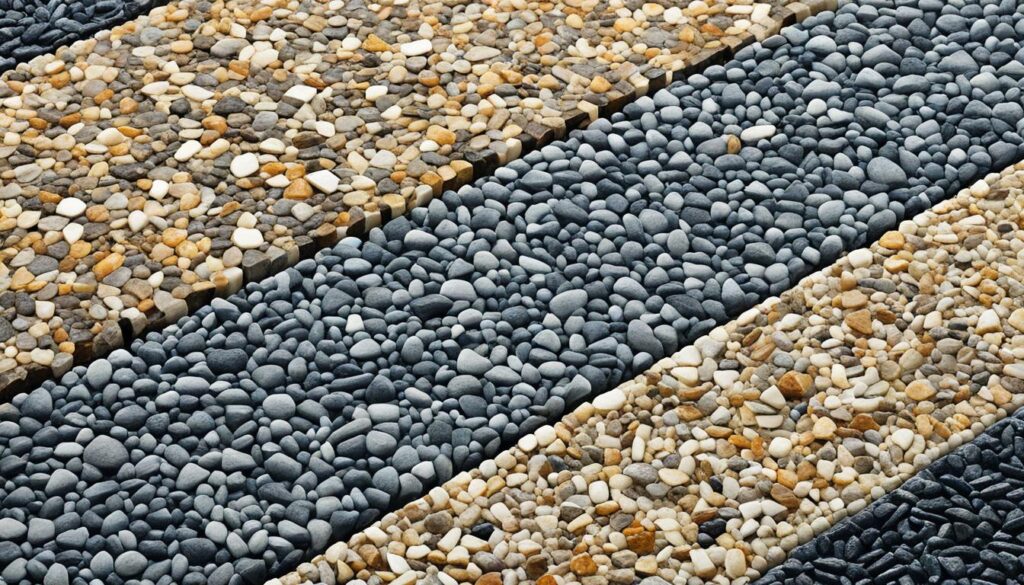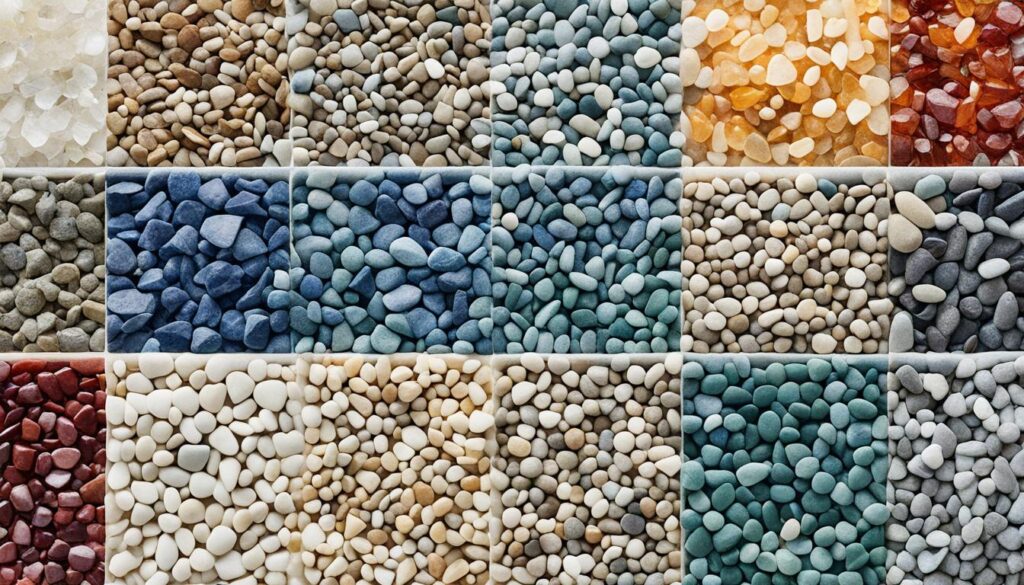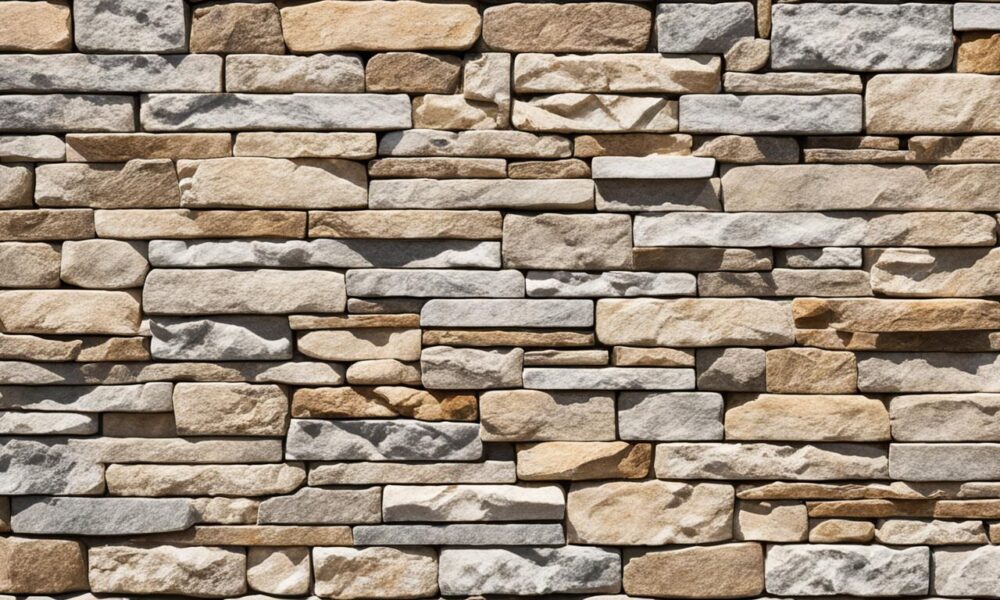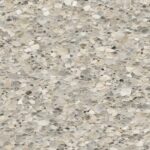Uncovering the Hardest Natural Stone Varieties
The durability and resilience of natural stones are greatly influenced by their hardness. The Mohs scale, developed to measure the hardness of minerals, provides valuable insight into the strength of different stone varieties. Understanding the hardest natural stones can aid in making informed decisions when selecting materials for countertops and architectural projects.
Key Takeaways:
- Hardness is an important factor in determining the durability of natural stones.
- The Mohs scale ranks minerals from 1 (softest) to 10 (hardest).
- Diamond is the hardest mineral with a ranking of 10, while talc is the softest at 1.
- Granite and gemstone rank amongst the hardest natural stones at 8 on the Mohs scale.
- Consider factors beyond hardness when selecting a hard stone countertop, such as budget and maintenance requirements.
Understanding the Mohs Scale of Hardness
The Mohs scale of hardness, developed in 1812 by Friedrich Mohs, is a valuable tool for evaluating the hardness of natural stones. This scale measures the scratch resistance of minerals and ranks them on a scale from 1 to 10. The higher the ranking, the harder the stone and the more resistant it is to scratching.
The Mohs scale assesses the ability of minerals to scratch or be scratched by other minerals. By comparing the scratch resistance of different stones, the scale helps in selecting the most suitable stone countertop materials for various applications. When choosing a stone for a countertop, it is essential to consider its hardness to ensure long-lasting durability.
At the top of the Mohs scale is diamond, with a ranking of 10, making it the hardest mineral. Talc, with a ranking of 1, is the softest. In between, there are various natural stones that fall within different ranges on the scale. Granite and gemstone, with a ranking of 8, are among the hardest stones, while limestone and travertine, with a ranking of 3, are on the softer end of the spectrum.
Here is a breakdown of the Mohs scale of hardness:
| Ranking | Mineral |
|---|---|
| 1 | Talc |
| 2 | Gypsum |
| 3 | Calcite |
| 4 | Fluorite |
| 5 | Apatite |
| 6 | Orthoclase Feldspar |
| 7 | Quartz |
| 8 | Topaz |
| 9 | Corundum |
| 10 | Diamond |
Understanding the Mohs scale of hardness allows homeowners, interior designers, and architects to make informed decisions when selecting natural stone materials for countertops and other applications. By choosing a stone with a higher ranking on the Mohs scale, such as granite or gemstone, one can ensure a countertop that is more resistant to scratches and maintains its beauty over time.
Hardest Natural Stone Varieties for Countertops
When it comes to choosing the perfect countertop for your kitchen or bathroom, durability is a top priority. Hardness plays a crucial role in determining a stone’s ability to withstand everyday wear and tear. In this section, we will explore the hardest natural stone varieties for countertops, helping you make an informed decision for your home.
| Natural Stone | Mohs Scale Ranking |
|---|---|
| Granite | 8 |
| Gemstone | 8 |
| Quartzite | 7 |
| Quartz | 7 |
| Onyx | 7 |
| Marble | 4 |
| Travertine | 4 |
| Slate | 4 |
| Limestone | 3 |
| Soapstone | 1 |
According to the Mohs scale of hardness, granite and gemstone top the list as the hardest natural stone countertop materials, with a ranking of 8. These stones are incredibly resistant to scratching and other damages, making them an excellent choice for high-traffic areas.
Quartzite, quartz, and onyx closely follow with a ranking of 7. Although slightly softer than granite and gemstone, these materials are still highly durable and unlikely to scratch easily, making them suitable options for countertops.
Marble, travertine, and slate fall in the middle of the hardness spectrum, with a ranking of 4. While these stones offer a unique aesthetic appeal, they are more prone to scratching and may require extra care.
Limestone, with a ranking of 3, and soapstone, with a ranking of 1, are the softest countertop choices. While they may not possess the same level of durability as harder stones, they can still be utilized in less heavily used areas.
Take a moment to visualize the hardness rankings of these natural stone varieties using the table below:
With this knowledge, you can make an informed decision when selecting the perfect natural stone countertop that balances both beauty and durability for your home.
Factors to Consider When Choosing a Hard Stone Countertop
When selecting a hard stone countertop, there are several factors beyond hardness that you should consider. While hardness is undoubtedly important, it is not the sole determining factor in making the right choice for your countertop. Taking into account other key factors, such as budget, tolerance for scratches, aesthetics, and maintenance requirements, will help you make a well-informed decision that meets both your practical and aesthetic needs.
Budget
One of the factors to consider when choosing a hard stone countertop is your budget. Granite, for example, tends to be more affordable compared to gemstone countertops. By assessing your budgetary constraints, you can narrow down your countertop choices and explore suitable options within your price range.
Tolerance for Scratches
“It’s important to assess your tolerance for scratches when selecting a hard stone countertop”, says Laura Thompson, an interior designer. “Some stones, such as soapstone, develop a patina over time that adds character but also exhibits scratches. Understanding the maintenance requirements and the effect of wear and tear on the countertop’s appearance will help guide your decision-making process.”
Aesthetics
Another crucial factor to consider is the aesthetic appeal of the countertop. Different hard stone varieties offer a wide range of colors, patterns, and finishes that can enhance the overall look of your space. It’s essential to choose a countertop that complements your existing decor and personal style.
Maintenance Requirements
Maintenance requirements should also be taken into account when choosing a hard stone countertop. Some stones may require regular sealing or specific cleaning products to maintain their appearance and durability. By understanding the maintenance needs of different stone options, you can choose a countertop that aligns with your desired level of maintenance commitment.
“Finding the right balance between hardness and maintenance is crucial,” explains Mark Johnson, a countertop specialist. “There are hard stone options that require less maintenance, such as granite, while others may require more care and upkeep. Considering your lifestyle and how much time you are willing to invest in countertop maintenance will help you select the best option for your needs.”
By carefully evaluating factors beyond hardness, including budget, tolerance for scratches, aesthetics, and maintenance requirements, you can make an informed decision when choosing a hard stone countertop. Taking a holistic approach will ensure that your countertop not only withstands the test of time but also meets your expectations in terms of functionality and visual appeal.
Factors to Consider When Choosing a Hard Stone Countertop
| Factors to Consider | Description |
|---|---|
| Budget | Assess your budget to determine affordable options |
| Tolerance for Scratches | Consider the countertop’s ability to develop a patina and visibly exhibit scratches over time |
| Aesthetics | Choose a countertop that matches your desired style and complements your space’s decor |
| Maintenance Requirements | Evaluate the care needed to maintain the countertop’s appearance and durability |
Hardness and Durability of Natural Stones
The hardness of a natural stone directly influences its durability. Harder stones are more resistant to wear and tear, making them suitable for high-traffic areas such as kitchen countertops. Stones with a higher ranking on the Mohs scale are less likely to scratch or chip, providing long-lasting performance. It is crucial to choose a natural stone that meets the specific durability requirements of the intended application to ensure its longevity and satisfaction with the investment.

When selecting a natural stone for a countertop, it is important to consider not only its aesthetic appeal but also its hardness and durability. Hardness refers to the stone’s ability to resist scratching and being damaged over time. By choosing a stone with a higher hardness rating on the Mohs scale, homeowners can ensure that their countertops will withstand daily use and maintain their beauty for years to come.
Granite and gemstone are among the hardest natural stone countertop materials, ranking at 8 on the Mohs scale. They are highly resistant to scratches and can withstand heavy use without losing their original quality. Quartzite, quartz, and onyx are also popular choices for their durability, with a Mohs scale rating of 7.
On the other hand, softer stones like marble, travertine, and slate have a Mohs scale rating of 4, making them more susceptible to scratching and chipping. While these stones can still be used in countertop applications, extra care must be taken to prevent damage.
The table below provides an overview of the hardness and durability of popular natural stone countertop materials:
| Stone Type | Mohs Scale Rating | Durability |
|---|---|---|
| Granite | 8 | Highly durable; resistant to scratches and chipping |
| Gemstone | 8 | Highly durable; resistant to scratches and chipping |
| Quartzite | 7 | Durable; resistant to scratches and chipping |
| Quartz | 7 | Durable; resistant to scratches and chipping |
| Onyx | 7 | Durable; resistant to scratches and chipping |
| Marble | 4 | Less durable; more prone to scratching and chipping |
| Travertine | 4 | Less durable; more prone to scratching and chipping |
| Slate | 4 | Less durable; more prone to scratching and chipping |
Aesthetics and durability should be balanced when choosing a natural stone for a countertop.
While hardness is an important factor to consider, it should not be the sole determining factor in choosing a natural stone countertop. Aesthetics, maintenance requirements, and budget also play a significant role in the decision-making process. For example, while soapstone is softer with a Mohs scale rating of 1, it is still a popular choice due to its unique appearance and heat resistance.
Ultimately, finding the perfect balance between hardness and aesthetic preferences is key to selecting a durable natural stone countertop that will withstand the test of time and bring beauty to any space.
The Role of Cleavage in Stone Hardness
The hardness of a stone is not solely determined by its position on the Mohs scale, but also by its cleavage planes. Cleavage refers to the tendency of a mineral to split along certain flat surfaces. Stones with perfect or good cleavage may be more prone to damage, as they can easily chip or break along these planes. Proper orientation plays a crucial role in cutting and shaping gemstones to maximize their durability and minimize the risk of cleavage-related issues.
Understanding Cleavage in Stones
Cleavage is an inherent property of minerals and is influenced by their atomic structure. Some minerals have well-defined cleavage planes, which makes them break along specific directions more easily than others. These cleavage planes are determined by interatomic bonding forces within the crystal lattice of the mineral.
Stones with perfect cleavage have cleavage planes along which they can be split with minimal force, resulting in smooth and flat surfaces. Examples of stones with perfect cleavage include mica and gypsum. On the other hand, stones with poor or no cleavage, such as quartz and garnet, do not have specific planes along which they easily split.
Good cleavage refers to stones that exhibit prominent cleavage but may require more force to break along these planes compared to stones with perfect cleavage. Examples of stones with good cleavage include feldspar and calcite.
The Impact of Cleavage on Stone Durability
The presence of cleavage planes in a stone can significantly affect its durability. Stones with perfect or good cleavage are more susceptible to damage as they can chip or break easily along these planes. For example, a gemstone with perfect cleavage accidentally dropped on a hard surface may split into pieces along its cleavage planes.
When it comes to cutting and shaping gemstones, jewelers and lapidaries carefully consider the orientation of the stone to minimize the risk of cleavage-related issues. By aligning the facets and cuts with the cleavage planes or avoiding them altogether, they can create stronger and more durable gemstone designs.
| Stone Type | Hardness on Mohs Scale | Cleavage |
|---|---|---|
| Diamond | 10 | Poor or none |
| Quartz | 7 | None |
| Mica | 2.5-4 | Perfect |
| Calcite | 3 | Good |
| Garnet | 6.5-7.5 | None |
Table: Examples of stones with different hardness and cleavage properties.
Cleavage is an important factor to consider when choosing a stone for specific applications. A stone with poor or no cleavage may be more desirable for durability, as it is less prone to chipping or breaking. However, stones with cleavage can still be used effectively if their orientation is carefully considered during cutting and shaping.
Image:
Practical Applications of the Mohs Scale in Stone Selection
The Mohs scale, an established method for evaluating the hardness of natural stones, has widespread practical applications in the stone selection process, especially in commercial construction. This scale provides architects, designers, and homeowners with a valuable tool to assess the suitability of different stones for various applications based on their hardness. By considering the Mohs scale in stone selection, one can confidently choose a beautiful, strong, and durable natural stone that meets the specific requirements of their project, ensuring long-term satisfaction and optimal performance.
Architects and designers rely on the Mohs scale to evaluate the hardness of stones when selecting materials for projects. By assessing the hardness of various stones, professionals can determine whether a particular stone is suitable for high-traffic areas, like flooring or countertops, or if it is better suited for less demanding applications. Understanding the Mohs scale allows them to make informed decisions about the durability and resilience of natural stones in architectural designs.
One practical application of the Mohs scale is in the selection of stone countertops. Homeowners seeking durable countertop materials can refer to the Mohs scale to identify stones that have higher rankings, indicating enhanced scratch resistance and overall durability. Stones like granite and gemstone, which score an 8 on the Mohs scale, are excellent choices for kitchen countertops as they are highly resistant to scratches and other damages.
“The Mohs scale is an indispensable tool that helps us guide our clients towards stone choices that align with their specific requirements. By evaluating the hardness of stones, we can ensure that their beauty is matched by durability, providing long-lasting performance in various applications.”
Hardness Rankings on the Mohs Scale for Common Natural Stones
| Stone | Mohs Scale Ranking |
|---|---|
| Granite | 8 |
| Gemstone | 8 |
| Quartzite | 7 |
| Quartz | 7 |
| Onyx | 7 |
| Marble | 4 |
| Travertine | 4 |
| Slate | 4 |
| Limestone | 3 |
| Soapstone | 1 |
Table: Hardness Rankings on the Mohs Scale for Common Natural Stones
The table above presents the hardness rankings on the Mohs scale for common natural stones. It serves as a helpful reference guide for stone selection, providing a clear overview of the relative hardness of different stone varieties. Stones with higher rankings are generally more durable and resistant to scratches, making them suitable for demanding applications.
By considering the Mohs scale in stone selection, one can choose a natural stone that not only showcases its inherent beauty but also offers the desired strength and durability required for a specific project. Whether it is for architectural designs, countertops, or other applications, assessing the hardness of stones using the Mohs scale allows individuals to make informed decisions and confidently select the most suitable natural stone for their needs.

The Importance of Hardness in Natural Stone Architecture
In the world of natural stone architecture, hardness is a fundamental characteristic that greatly impacts the long-term durability and performance of stone installations. The hardness of a stone determines its ability to withstand external forces, resist damage, and maintain its aesthetic appeal over time.
When it comes to architecture, natural stones are often used in high-traffic areas, such as floors, staircases, and exterior facades. In these applications, the hardness of the stone is of paramount importance. Harder stones, which rank higher on the Mohs scale of hardness, exhibit exceptional resistance to scratching, chipping, and weathering.
Consider a bustling commercial building with heavy foot traffic. The floors and staircases of such a structure should be constructed with hard stones that can withstand constant usage without showing signs of wear or damage. Similarly, exterior facades should be composed of stones that can endure exposure to the elements without losing their beauty or structural integrity.
The careful consideration of hardness in natural stone architecture enhances the longevity and durability of the installations. By selecting stones that rank high on the Mohs scale, architects and designers can ensure that their projects stand the test of time and deliver a lasting impact.
Furthermore, the aesthetic appeal of natural stone architecture is greatly enhanced by using hard stones. These stones maintain their pristine condition and exquisite beauty, even after prolonged use or exposure to environmental factors. Their durability preserves the initial investment and reduces maintenance costs, making them a popular choice for architects, designers, and homeowners alike.
In conclusion, hardness is a crucial factor to consider in natural stone architecture. It determines the resilience and longevity of stone installations, ensuring that they can withstand external forces and retain their aesthetic appeal for years to come. By selecting hard stones for various architectural applications, professionals can create structures that not only exude beauty but also deliver remarkable durability and functionality.
Conclusion
The selection of natural stones for various applications is greatly influenced by their hardness. By understanding the Mohs scale and evaluating the hardness of different stone varieties, homeowners and professionals can make informed decisions. From granite and gemstone to quartzite and quartz, there is a wide range of hard stone countertop choices available that offer exceptional durability and resilience.
While considering the hardness of natural stones is crucial, it is important to take into account other factors such as budget and maintenance requirements. Each stone has its own unique characteristics and suitability for different applications. By weighing these factors, individuals can find a durable and enduring material that meets their specific needs.
Choosing a hard and durable stone is essential for long-term satisfaction and performance. Whether it’s for a kitchen countertop, a flooring project, or an exterior application, the right natural stone with strong mineral composition can withstand wear and tear, resist scratching, chipping, and weathering, and maintain its aesthetic appeal over time.
By considering the hardness of natural stones, individuals can confidently select the hardest natural stone for their desired application, ensuring a beautiful, durable, and long-lasting addition to their space.



